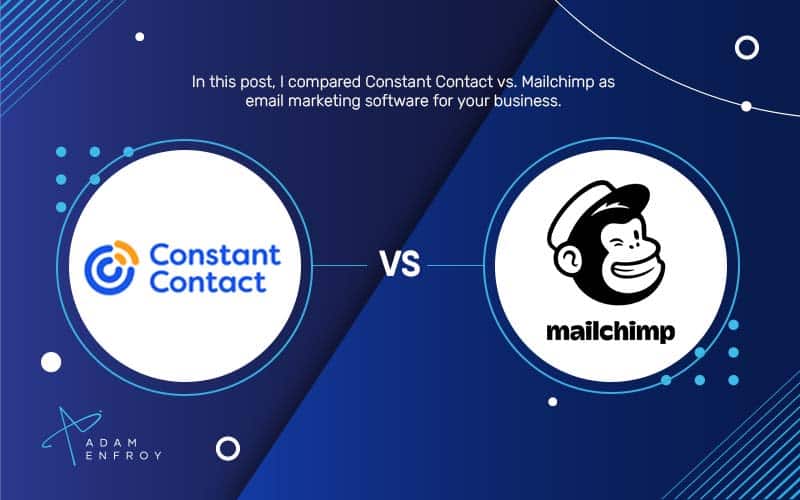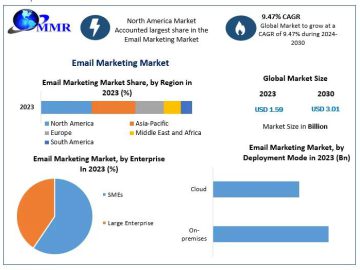If you’re building an online business, then you know you need to incorporate email marketing into your overall digital marketing strategy.
And two of the most prominent email marketing services that come to mind are Constant Contact vs Mailchimp.
Since email is one of the most prominent marketing channels out there, which one of these email providers is better?
This ultimate guide to Constant Contact and Mailchimp will go cover the features of each option so that you can make the right choice for your email marketing platform.
According to a recent study, the median email marketing ROI is 122%. That’s 4x higher than any other digital marketing channel.
Moreover, according to the estimate, the US will spend around $350 million on email marketing alone in 2019.
Your email service is an important decision to make – so which is it? Constant Contact? Or Mailchimp?
Let’s dive into their features so you can make the right choice.
Constant Contact was established in 1995 and has its headquarters in Waltham, Massachusetts.
With annual revenue of more than $330 million, more than 1200 employees, and over 600,000 global customers, it is one of the largest email service providers in the world.
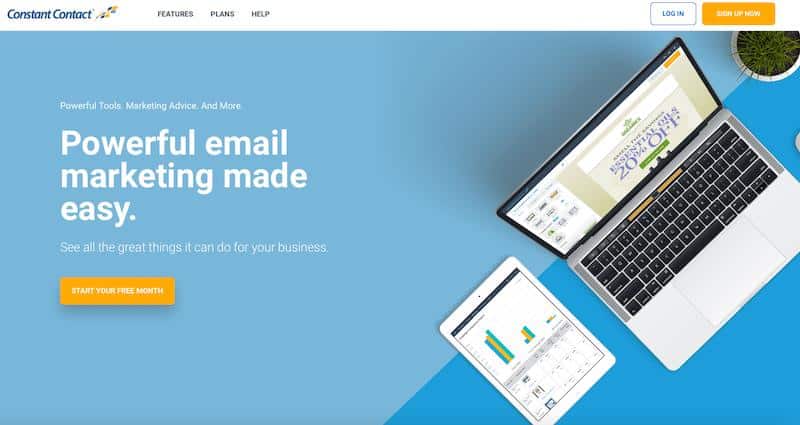

Some of its most prominent features include:
- Attractive email templates
- Email editing tools
- A/B testing tools
- Excellent deliverability
- Advanced email tracking features
- Image library and file hosting
Mailchimp is another popular marketing automation platform and email service provider. Established in 2001, it has its headquarters in Atlanta, Georgia.
With nearly 1000 employees and more than $500 million in revenue, it regularly features in the ‘Forbes Cloud 100’ list.
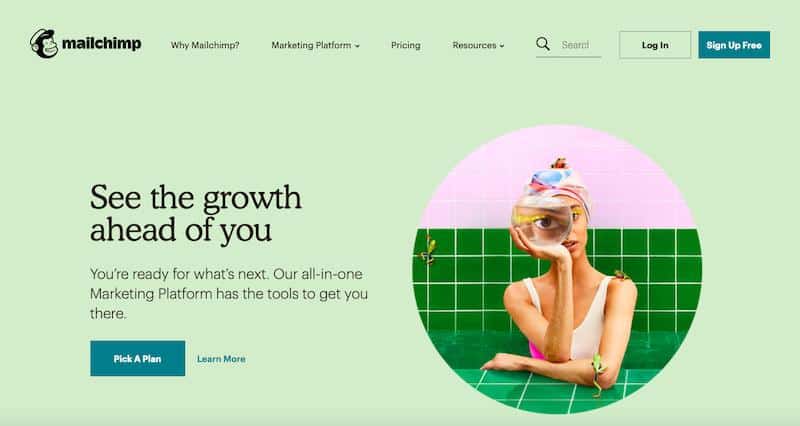

Some of Mailchimp’s most prominent features include:
- Drag-and-drop editor to design own emails
- Highly advanced analytics
- Email personalization
- Engaging landing pages
- Track real-time statistics
At face value, both Mailchimp and Constant Contact look quite similar.
Let’s dive under the hood to see which is best in 2020.
Pricing Plans & Features.
Constant Contact provides two pricing plans, nameld “Email,” and “Email Plus.”


The ‘Core’ plan is $9.99 per month, and the ‘Plus’ plan costs $45 per month.
Both the prices are based on the number of contacts you have.
However, while the Email plan is suited for small businesses looking to create professional emails, the Email Plus plan is more appropriate for small businesses looking to automate email marketing.
The good news is that you get a two-month free trial, which allows you to get familiar with the tool and test whether it aligns with your requirements or not.
Here are some of the common features offered by all the paid plans:
- Customizable Templates
- Contact Management Tools
- Email Scheduling
- Live Support
- List-Building tools
- Mobile App
- Facebook & Instagram Ads
- Marketing Calendar
- Apps & Integrations
- Contact List Import
- Image Library
- Pre-designed Landing Pages
- Tracking & Reporting Advanced Features
- Easy Drag-and-Drop Features
Constant Contact is rich in features and offers more than 240 custom-designed, mobile-responsive templates to choose from.
You also get a lightweight library function that has made adding images to your emails extremely easy.
Mailchimp also provides plans according to the size of your audience list.
However, all the plans have a monthly cap on the number of emails you can send.
As of May 2019, beginners and those switching from the free version to monthly plans will start getting charged per contact instead of simply subscribed contacts.
It provides four pricing plans, one of which is entirely free and offers all the basic email features for businesses that are just getting started.
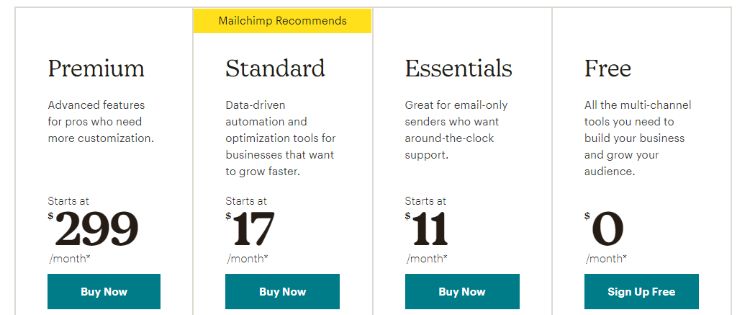

The Mailchimp pricing plans are as follows:
- The ‘Free’ plan offers a monthly limit of 10, 0000 emails.
- The ‘Essentials’ plan starts at $11 per month and offers 500 contacts and 500,000 emails.
- The ‘Standard’ plan starts at $17 per month and has advanced automation.
- Finally, the ‘Premium’ plan provides you all-area access from $299 per month.
Mailchimp’s email services allow you to:
- Sell products
- Make announcements
- Tell stories
- Follow-up
- Explain your products in-depth
With Mailchimp, you also get a wide range of templates, with over 100 highly customizable ones to choose from.
Here, you can use email personalization to significant effect.
You just have to fill in your name and get to send your email according to the correct time zones.
Winner: Constant Contact.
Constant Contact has a lot of options to choose from, including more than double the number of templates that Mailchimp offers.
They also have great plans that are highly customizable according to the business needs and wants of the user.
On top of that, they offer similar features to Mailchimp at a much lower price with more subscribers.
Email Marketing Automation Features.
Email marketing automation makes your life easier by sending out automated emails to an entire list of recipients and determining the type of email that needs to be sent to a specific audience.
Constant Contact has in-built email marketing features and automation capabilities that are specifically useful for small businesses and non-profit organizations to set up unlimited emails automations.
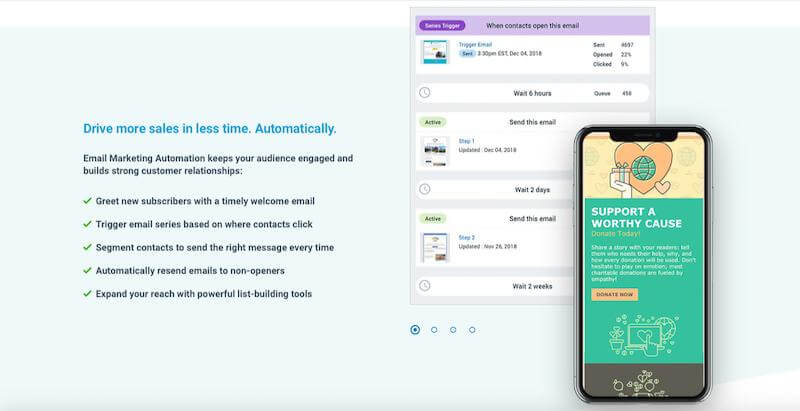

Using the automation tools offered by Constant Contact, you can drive up customer engagement, and offer them a much-enhanced user experience, which can boost sales and improve customer retention.
Constant Contact’s automation tool allows you to:
- Welcome emails to new contacts sent automatically
- Nurture leads (create effective drip campaigns to target contacts)
- Engage your audience (by segmenting them and sending the right messages to the right people)
- Expand your outreach (add contacts)
They also let you create auto-responders to new joiners, which allow you to get more value out of each email you send.
Mailchimp also has excellent email automation features.
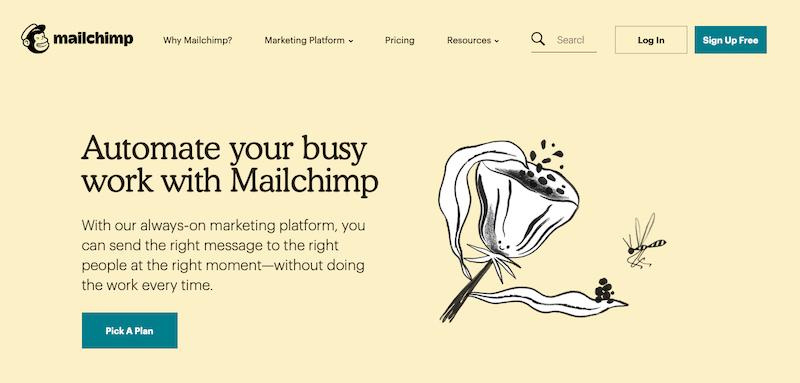

It offers integration with your website and can help you send targeted emails based on the lead activity on your website. It provides options to choose a single email or email series by a single click.
With Mailchimp, you can do a lot of things like:
- Send emails to visitors after they visit a specific page on your website
- Goal integration (pool leads who go from your campaign to a specific page)
- Use purchase data to send customers product recommendations
A distinct drawback here is that the automation plan is not bundled into the free plan for Mailchimp, and you need to get a subscription for it.
Winner: Mailchimp.
It’s a very tough call in between these two industry stalwarts. However, Mailchimp narrowly wins this round since it can provide you with behavior targeting emails, which is very important in email marketing.
List Management & Segmentation.
List management and segmentation are vital when it comes to email marketing.
Constant Contact offers some of the best list management and segmentation features.
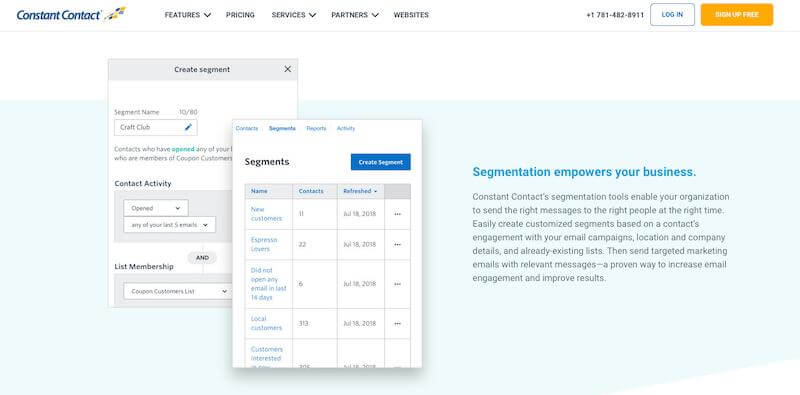

Basically, you can do a lot of things with Constant Contact, including:
- Add contacts to your list
- Group them for targeted campaigns (here, you can use tags, which can help you make groups based on interests, customer status, locations, and more)
- Send targeted emails
Tagging contacts is very simple and can be done at the click of a button on the toolbar. It’s simple to use, and very effective to deploy.
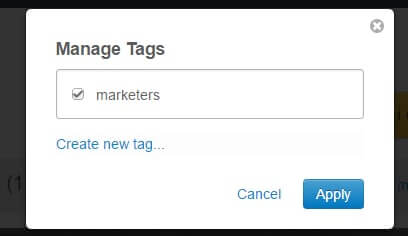

You can also easily remove the contact details of someone who is non-responsive or disinterested.
What’s more, Constant Contact offers a free video tutorial for a visual demonstration of how to use it for list management and advanced segmentation.
Furthermore, you can build your email list via the opt-in or sign-in form and can import contacts from Excel, Outlook, Salesforce, your ecommerce platform, or even a place where you store your email contacts.
They also have a very powerful email list management (cleaning) service that automatically clears duplicate and unsubscribed contacts for you.
Mailchimp, on the other hand, does not offer such user-friendliness.
Here, groups and segments have different meanings and may confuse users. ‘Groups’ are used for organizing, and ‘segments’ are used for filtering.
To create a segment, you can simply click on ‘Create a segment,’ add the filters you want to use and preview.
You can also create groups by going to ‘Manage contacts’ and clicking on ‘create groups.’
It also provides plenty of scope for personalization.
With Mailchimp, you can import a list in four ways:
- Upload CSV file
- Copy/paste from Excel
- Import from apps like Salesforce, Google Docs
- Create a list
Winner: Constant Contact.
Constant Contact wins this round for its unparalleled user-friendliness. The best part about Constant Contact is its ‘tagging’ feature that is distinctly missing in Mailchimp.
Email Deliverability.
Email deliverability can be defined as the number of times your email lands up in the inbox of the intended recipient, instead of the spam folder.
One of the benefits of using email marketing software is that unlike Gmail or other email services, they’ll let you know when a message enters the inbox.
Otherwise, there’s no way of knowing whether your email actually reached the recipient’s inbox or went to the spam folder.
Constant Contact is an industry leader when it comes to email deliverability.
They are 100% compliant with CAN-SPAM and CASL legislation, which help them maintain a deliverability rate of about 97 percent.
It is the best standard in the industry and has been audited and confirmed by third-party vendors.
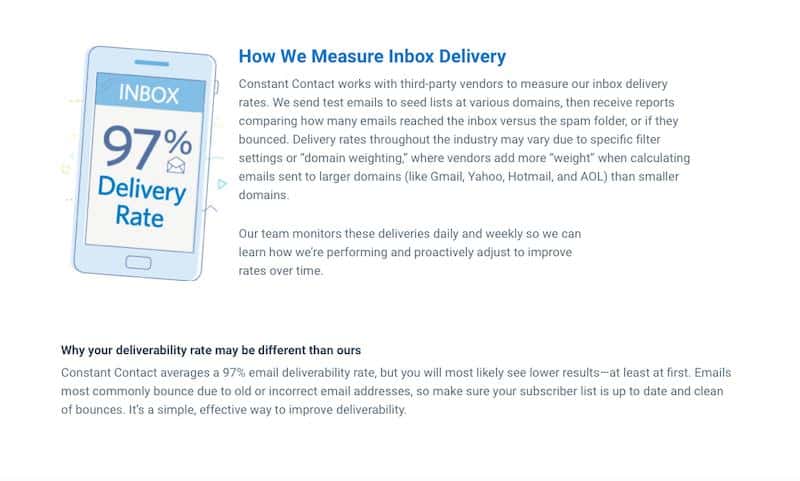

Some of the ways Constant Contact maintains a high deliverability rate are:
- Proactive monitoring (prevents network abuse)
- Feedback analysis (registered with all major Internet Service Providers to get regular feedback)
- Authentication
- Constant tracking of blocklists
- Superior compliance
- Regular account reviewing (minimal scope for error)
Mailchimp, on the other hand, provides a deliverability rate of 96% most of the time, which is not a very bad number.
However, the exact delivery rate isn’t mentioned on the official website.
It also puts special emphasis on quick delivery of emails and allows you to send up to 1 million emails in 45 minutes.
However, deliverability is quite obviously lower than Constant Contact.
Mailchimp maintains high deliverability by:
- Internet Service Providers feedback loops and whitelists (efficient spam handling)
- Abuse detection technology
- Authentication (very accurate tracking)
Winner: Constant Contact.
Constant Contact has a lot of great features that help it uphold high deliverability.
At 97%, Constant Contact has the best numbers in the industry and hence wins this round.
Ease of Use: Importing and Exporting.
Both Constant Contact and Mailchimp are the best in the industry when it comes to giving options for importing your existing contacts into their platforms.
For Constant Contact, all your contacts stored in the formats like XLS, KLSX, and CSV (spreadsheet file), vCard file (VCF), and text files can be imported directly.
You can add them one after the other, or all at once, together.
Moreover, it offers you multiple options to store, import, and integrate customer contact information.
When you are importing, the following steps are helpful:
- One email address per individual contact
- File type should be compatible
- Properly label column headings
- Remove extra spaces and special characters
Furthermore, Constant Contact can import files with 40,000 contacts or less in a considerably small amount of time.
However, the feature of importing new contacts to your account can vary according to the pricing plan you choose.
For Mailchimp, you can directly import CSV or text files. In case the files are XLS or XLSX, you need to copy and paste them.
You can also use Mailchimp to update existing contacts automatically.
It also provides an API, targeted at experienced users, who can use it to add contacts to an audience.
However, when importing files with a large number of contacts can render the process slow.
Here’s a guide by Mailchimp that gives you a detailed insight into how to import contacts to Mailchimp.
Both Mailchimp and Constant Contact also provide in-depth troubleshooting details to help users.
Constant Contact provides features like direct import for maximum file formats. Also, Constant Contact can handle files when you upload contacts much better than Mailchimp.
Thus, the winner of this round is Constant Contact.
Email Analytics & Reporting.
By making everything more measurable, email analytics help companies achieve their ROI targets like never before.
By tracking email opens, clicks, purchases, unsubscribes, and more, you can view data by individual email or subscriber.
To help businesses track their email marketing efforts, Constant Contact provides an in-built email tracking tool that offers easy-to-read reports to track marketing success in real-time.
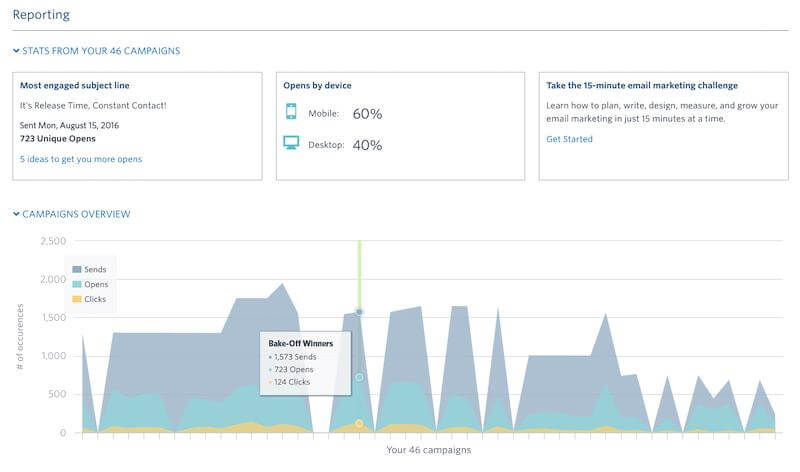

Constant Contact’s analytics tool also provides:
- Detailed engagement report (watch sends, clicks and more. Monitor performance of your campaign and identify most efficient respondents)
- Compare email campaigns (compare up to 5 campaigns at one time)
- Click-tracking heat map (tracks the links that got the most number of clicks. Circles get larger as the number of clicks increase)
- Click segmentation (effectively segment contacts based on the content they click. Empower you to identify and form specific groups, for creation of more relevant content and concerted targeting)
- Track mobile open rate
- Google Analytics integration
The Constant Contact app makes it easy to study all the critical metrics related to your email marketing and make informed decisions.
Mailchimp also has an excellent in-built analytics tool that can help you see what’s working for your business. It makes it easier for you to track performance and create better email marketing campaigns.
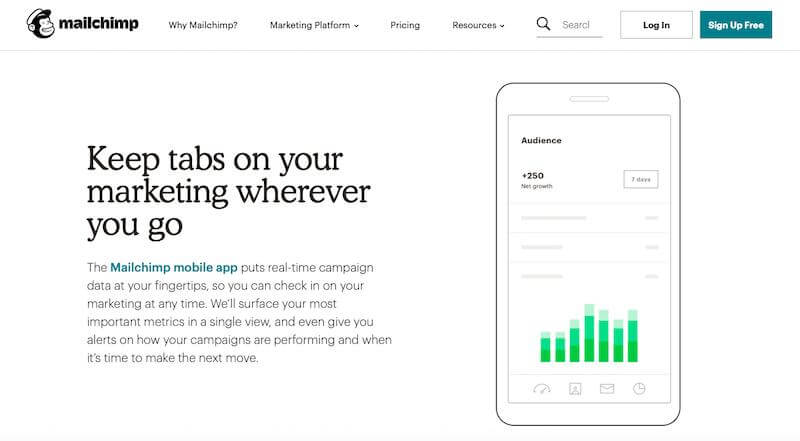

Mailchimp’s in-built analytics tool helps to:
- Pool all the marketing campaigns (emails, automation, social advertisements) on the same platform for real-time statistics visualization
- Make informed decisions through their growth, engagement and revenue reports (track click-through rate, downloads, and purchases)
- Efficiently monitor ROI (track sales along the sales funnel, from click to purchase)
- Monitor money earned (as well as what was bought)
Mailchimp also offers a mobile app that allows you to:
- Provides access to real-time campaign data
- Surface all metrics in a single window
- Provide alerts on campaign performance at regular time intervals
Winner: Constant Contact.
Both Constant Contact and Mailchimp have great features when it comes to analytics and reporting. But Constant Contact is the narrow winner due to relatively better features.
Sign-Up and Opt-In Forms.
Your registration or sign-up is an essential part of your sales funnel and is one of the factors that will help you grow your email list.
Thus, your sign up forms should be attractive and comfortable to fill.
Keeping this in mind, Constant Contact offers an effortless way to create a sign-up form.
You can add the sign-up form on any page of your website that you want, and even in multiple pages.
Constant Contact offers a variety of sign up forms, including:
- Pop-up (display pop-up that can nudge the customer into signing up)
- Inline (insert the sign-up form anywhere on your website you want)
- Facebook lead ad (create Facebook ads)
You can further personalize by giving it a specific title, and edit the content by simply clicking on the ‘content’ option to customize what information you want to appear on the sign-up form.
You can add fields like:
- Title
- Description
- Contact fields
- Email lists
- Button
- Background
After customization, all you need to do is activate and install it.
Mailchimp also provides one of the simplest sign-up forms in the industry.
Here too, you can attach sign-up forms on any page or multiple pages of your website.
You need to generate sign up forms using their ‘Form Builder’.
Mailchimp allows you to choose from four embedded form style designs, like:
- Classic
- Condensed
- Horizontal
- Unstyled
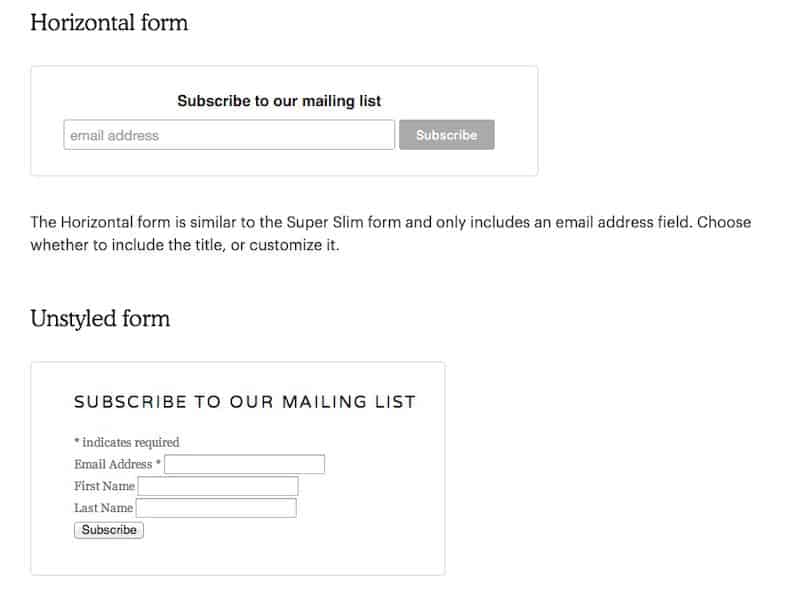

One of the best features is that the embedded and pop-up forms support any SSL certification on your website.
It also provides an intuitive, user-friendly interface.
Winner: Mailchimp.
Constant Contact doesn’t let you remove their brand logo for every sign-up form, and the feature is specific to a specific exclusive plan.
If your email plan doesn’t allow it, you need to upgrade it. But Mailchimp has better customizability, and more options to choose from.
Thus, Mailchimp wins this round.
A/B Testing.
Constant Contact helps you maximize your email open rates with split A/B testing of your subject line.
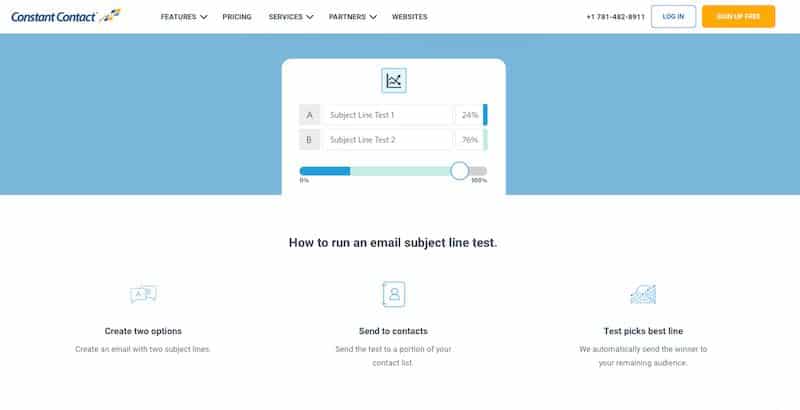

This feature lets you feel the pulse of your prospective leads, and help target them more effectively.
However, this A/B testing feature is only applicable for subject lines and doesn’t let you test any other attribute like an email template, etc.
Mailchimp’s A/B testing feature, on the other hand, allows you to compare up to 3 variations simultaneously and then decide the best one.
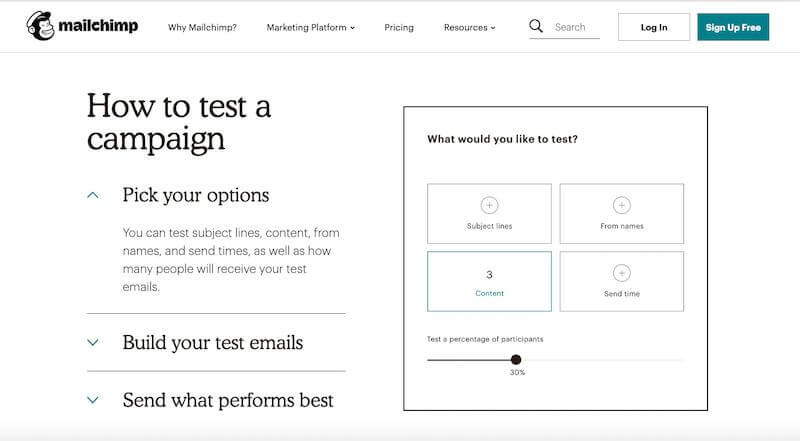

Their premium plan incorporates multivariate testing (involving more variables) and allows comparison of up to 8 variations at one go.
Mailchimp’s tool can also advise you on the amount of time you need to keep on performing A/B tests to arrive at the best, optimized results.
Here also, you can test the following:
- Subject lines
- Content
- From names
- Send times
- Number of targets receiving your mail
Winner: Mailchimp.
Constant Contact has got a lot of features going on in their favor. But Mailchimp has excellent attributes like multivariate testing, a wide choice of metrics, and greater flexibility. Therefore, Mailchimp wins this round.
Customer Support.
Constant Contact’s help and support center is a standout when it comes to customer support.
Constant Contact offers a variety of customer support options, via:
- Chat service
- Phone Support
- Video tutorials
- Ask the Community
- Professional services
- Educational events
- Apps & integrations
- Developer resources
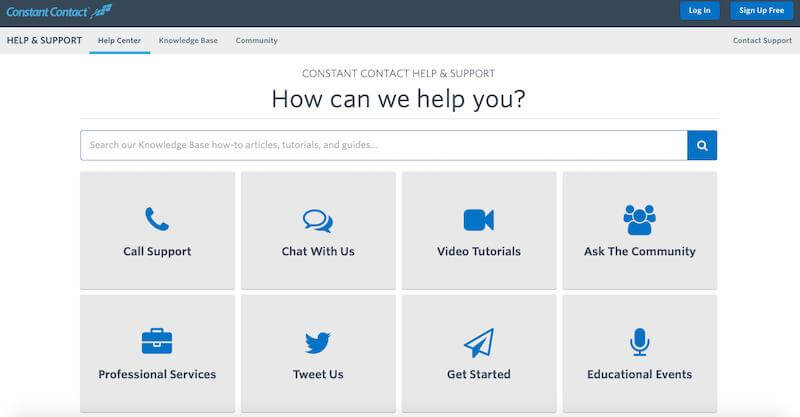

When it comes to phone support, you get billing support as well as international customer support.
On top of that, they offer call support even on Saturday, and community support and Twitter support are available seven days a week.
Not many online service providers offer such extensive customer support as Constant Contact.
Mailchimp support doesn’t fall far behind either.
It seems that they take this aspect of the business very seriously. And that’s well demonstrated in their free email support for 30 days, for new subscribers.


The customer support varies according to the kind of subscription you’re using. However, overall, you get 24/7 email support, and call support during business hours.
They also have a knowledge-based self-service, and a pretty efficient chat service when you need personal attention.
Furthermore, they provide a very comprehensive FAQ section that practically solves most of the problems you might face while using the email marketing tool.
Winner: It’s a draw.
Both Mailchimp and Constant Contact provides excellent customer support and world-class features.
Therefore, it’s a draw in this round.
Email Previewing Features.
It’s especially important to preview your emails before running a campaign because email templates can look different when viewed from different devices.
Constant Contact addresses this issue by allowing its users to see how the emails are going to look at the client’s device.
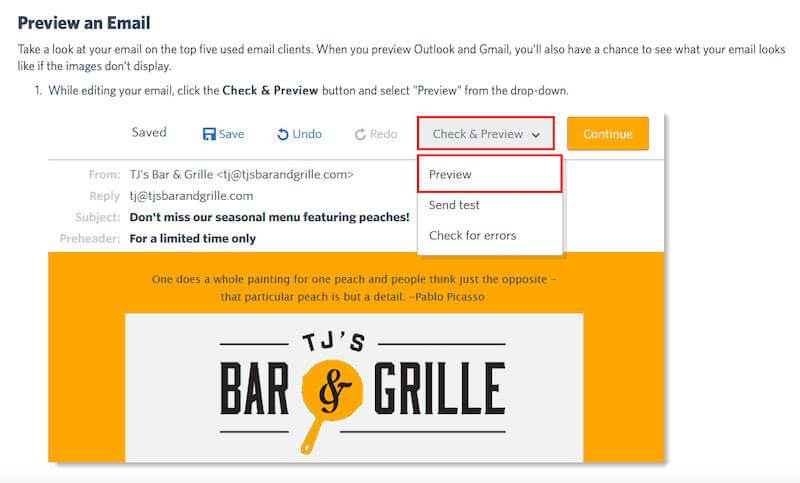

It can replicate the display on:
- Gmail
- Outlook
- Apple iPad
- Apple iPhone
- Google Android
- Mobile Devices
Using Constant Contact’s email previewing feature, you can also customize the appearance of your emails for maximum ease of use by clients.
With the email preview feature, you can observe the following:
- If the bottom of the email template gets cut off
- CTA placement to ensure if the link button is clearly visible or not
- Check if your images are off-appearance (as may sometimes occur in Outlook)
- Check for compatible font styles
You can immediately rectify any error or incompatibility issue so that your client gets the finest experience.
To address the email previewing issue, Mailchimp offers a Litmus-powered tool called Inbox Preview that can replicate precisely how your email will look in the client’s inbox.
The best part is that all Mailchimp users get free 30-day access to Litmus upon signing up.
If it’s a paid subscription, you can get 25 Inbox Preview tokens every month.
Creation or updating a preview is equivalent to one token.
Even if you’ve run out of tokens, you can still check the preview by:
- Comparing on mobile vs. desktop
- Sending test email
- Enabling the push notifications and pushing to mobile
Winner: Mailchimp.
The clear winner here is Mailchimp since it offers a wide array of email preview and compatibility options.
Third-Party Integrations.
Constant Contact offers users a wide range of integrations, which allows you to get the most of their email marketing solution.
In a recent survey, 69% of respondents suggested that integrations provided by Constant Contact have been central to their business success.
Many third-party tools integrated with Constant Contact allow you to sync contacts between your Customer Relationship Management (CRM) system and Constant Contact, add sign-up forms to your blogs, curate online content for your newsletters, and so forth.
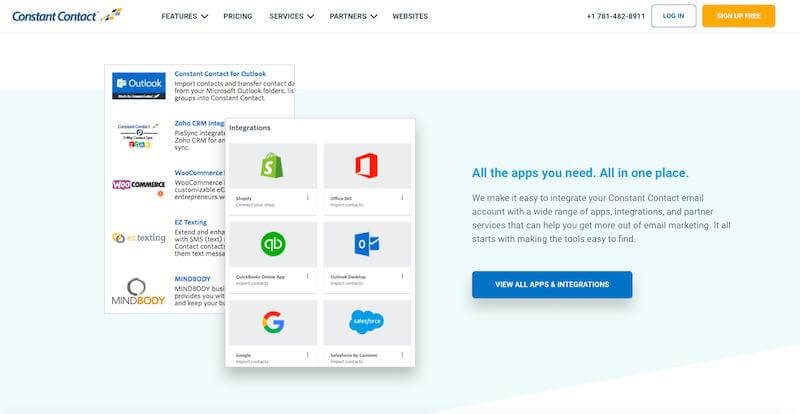

Constant Contact is fully integrated with the most important and widely used platforms, including:
- Eventbrite (used for managing and promoting events)
- Shopify and Magento (sync your Ecommerce online store with your account)
- Salesforce integration with Cazoomi (real-time lead engagement)
- WordPress (via the official Constant Contact plugin)
- MINDBODY (online booking, POS and more)
- WooCommerce (using Zapier)
- Viewbix
- MailMunch
A distinct attribute of Constant Contact is its integration with event management software – setting itself far above the rest in this area.
Mailchimp also works with a plethora of the most useful apps to make your email marketing easy.
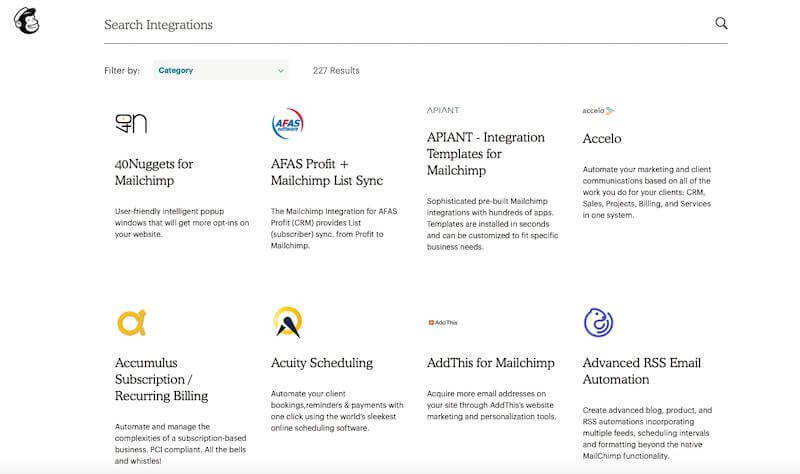

Mailchimp offers integrations with some of the best platforms like:
- Eventbrite
- Salesforce
- Shopify
- Square (connect payments to Mailchimp to sell directly from landing pages)
- WooCommerce (sync store data and send more personalized emails)
It has also integrated with some of the latest platforms that are aiding and abetting its increased user-friendliness:
- Xero
- Canva (helps you create the best graphics for your account)
- Shopware (sync your Shopware products, customers, and orders to Mailchimp)
Winner: Constant Contact.
Both the services are nearly evenly matched, but the integration and flexibility of Constant Contact are comparatively better than Mailchimp.
Therefore, the winner for this round is Constant Contact.
To wrap it up, both email solutions have their fair share of specific pros and cons.
While choosing one over the other, it is not very easy to make the decision. It’s essential to gauge which unique features you want out of the service.
Here, I’ve compiled a brief review of the features of both email marketing tools to help your buying decision.
Constant Contact Pros:
- Provides features like integration with event management, something that is unique among its peers
- The deliverability rate is the best in the industry (97%)
- Offers value for money (great features at standard prices)
- User-friendly (has an intuitive interface)
- Allows high level of personalization
- Providers auto-responders integrated with email
- Global user-base and goodwill
- Industry leader in data analytics and social media platforms integrations
- Can handle files with a large number of contact details
- Excellent knowledge base
Constant Contact Cons:
- Doesn’t let you remove the logo from every sign-up form
- Best suited for small businesses
- The website available in Spanish and English, but the tool is available only in English
- No provision for spam testing
- Email preview feature could be made better
Mailchimp Review.
Mailchimp Pros:
- Excellent data analytics and social media platforms integrations
- Provides a robust, drag-and-drop feature
- Offers a freemium plan with impressive features
- In-built customer relationship management tool (CRM)
- World-class customer support
- Offers great behavioral email targeting
- Offers one of the best A/B testing tools (multivariate analysis included)
- User-friendly software
- Has an excellent email preview feature
Mailchimp Cons:
- One of the priciest service providers in the market
- No integration with event marketing
- Doesn’t allow affiliate marketing
- Average deliverability (96%)
- Site is available only in English
Both MailChimp and Constant Contact are two of the most prominent tools in the email marketing industry and are globally used by millions of people in the world.
Mailchimp is most appropriate when it comes to customization, ease of use, automation, and ease of previewing emails.
However, if you are looking for a well-rounded experience, replete with excellent features, value for money, customer support, and user-friendliness, Constant Contact should be the choice for you.
It provides better overall features like integrations with event management software, better deliverability, and more advanced analytics.
As a special bonus to my readers, when you get started with Constant Contact, you’ll get 10% off your first year, plus:
- An expert Account Manager dedicated to your business
- Award-winning product and technical support
- Client hub to manage all your clients in one place
- Online portal with an extensive training library
- Certification, professional marketing tools, and more
Further reading on AdamEnfroy.com: Want to see how Constant Contact lines up against other email marketing software?
Check out my Constant Contact vs. ActiveCampaign comparison for more information.
Editorial Process:
Our reviews are made by a team of experts before being written and come from real-world experience. Read our editorial process here.
Some of the links in this article may be affiliate links, which can provide compensation to us at no cost to you if you decide to purchase a paid plan. These are products we’ve personally used and stand behind. This site is not intended to provide financial advice. You can read our affiliate disclosure in our privacy policy.
Last Updated on May 8, 2024 by Adam Enfroy
Adam Enfroy
Adam Enfroy is a full-time blogger, YouTuber, and affiliate marketing expert. Join AdamEnfroy.com to learn how to start an online business at startup speed. Before starting this blog, Adam managed digital marketing teams for large SaaS startups and reviews the best software to run your online business. He has been featured in over 100 publications, including Forbes, Business Insider, and Entrepreneur.

